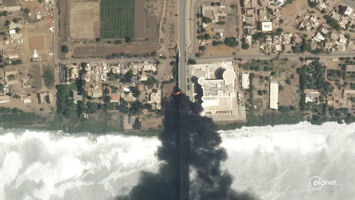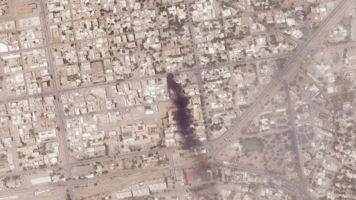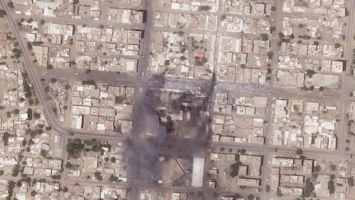Khartoum
The arid capital city (pop. 800,000) of Sudan, at the junction of the White Nile and Blue Nile, merits a stay of at least two nights. It’s an interesting place to walk around, snoop in shops and people-watch. Also take a ride on the Nile (in Khartoum or in nearby Omdurman), then visit the National Museum (antiquities from around the country), ethnological museum (tribal artifacts), natural-history museum (local bird and wild-game displays) and Sunt Forest (near the Hilton — a favorite spot for picnics).
Khartoum (also Al Khartoum) is the national capital of Sudan. It has an area of 22,122 km2 and an estimated population of approximately 7,152,102 (2008). Khartoum state is divided to 7 lower government level called Al-mahalyat, they translate it as localities, it is similar to districts, Municipalities. Khartoum as a modern capital of the country is full of tourist elements and infrastructures encouraging investment. In Khartoum there are a number of hotels and pensions of different degrees according to international classification. A number of restaurants, tourist resorts and conference halls are available. The three rivers White Nile, Blue Nile and the Nile formed the geographical map of the Khartoum state divided into three cities (Khartoum, Omdurman and Khartoum Bahri), each rich of the tourist components. Omdurman tourist attractions this region is located west of the White Nile and the Nile marked by its architectural aspects and the fortresses which featured the Mahdi State period and the old city of Omdurman. The region has many markets and folk industries, beside the land hunting site and the solitary time in the desert. Khartoum tourists attractions Khartoum state is located between the White Nile & the Blue Nile marked by its long shores and different religious and historical buildings, in addition to the Alsunt forest protectorate, Jabal Al-awliyaa Lake and many clubs of rowing and boats, various museums and other aspects and centers of the tourist service. West of Nile tourist attractions It lies north of Omdurman and extends north to the Al-sabaluka waterfalls from the western side of the Nile , full of tourist elements marked by antiquity in addition to historical sites and the features of natural tourism along the Nile and the desert . Jabal Awliyaa tourist attractions This lies south of Khartoum 60 km away on the White Nile and it is known for its Nile tourist facilities at the ALkhazan near to the fishing spots and the places where the migrating and settling birds gather. Khartoum Bahri tourist attractions It is located east of the Nile with many graves, domes and shady parks on the banks of the Nile river. The most fascinating sight is the juncture of the White and Blue Niles. Al Mogran Family Park, an amusement park, is located at the point where the rivers flow together. After spending time at the confluence, take a ferry to Tuti Island for a look at a typical rural village. Consider excursions to Jebel Aulia Dam (great spot for bird-watching, fishing, picnics and people-watching) and the Sabaloka Gorge (the Nile’s Sixth Cataract — it’s a three- or four-hour drive each way). Other trips — by four-wheel-drive vehicles or local buses — can be made to the ruins at Meroe and Shendi; they can be seen on a day trip, but we really recommend taking them in during a three-day trip.
The Mahdi’s state (1885 - 1898) defeated the Turkish government of Egypt and killed the last Hakimadar Charles Gordon on the steps of the stairs in Hakimadariapalace in the January 26, 1885. It began a national governance which demolished the Hakimadaria palace building and city of Khartoum was abandoned and the capital was transformed to Omdurman on the west bank of the Nile, and became the capital and the headquarter of the governance of Mahdist state (Caliph House) until the English Egyptian colonization.
The holiest site in Sudan is located across the Nile from Khartoum. Omdurman (pop. 526,000) makes a nice day trip to see the site of the Mahdi’s Tomb (nonbelievers aren’t permitted to enter), as well as Khalifa’s House (relics of the Mahdi and British Sudan). The Old Dervishes Fort Museum (exhibits from colonial times) and a huge, fascinating market (excellent silver jewelry) are worth seeing. Don’t miss the Hamed al Niel Mosque (Sufi “whirling” dervishes dance there an hour before sunset on Fridays). Omdurman presents quite a contrast to modern Khartoum. At the base of the Nile bridge, boat builders can be seen plying their trade. We consider Omdurman a must-see. 6 mi/10 km northwest of Khartoum.
During the English Egyptian colonialism period (1898-31 December 1955) Khartoum was rebuilt again to be the capital of the Sudan and Herbert Kitchener Pasha, the first governor general of Sudan to re-build the palace for the third time in 1899. He built it on the stones shape to the demolished Palace Hakimadaria In 1900 a large part of the palace building was completed and the second governor the Sir Reginald Wingate settled in it until the general mukhatt was completed to the rest of the palace and its annexes by the year 1906. And was erected with the red brick (brick), but the corners were built by sandstone.
The Palace consisted of a ground floor and two floors, and three pavilions ,a major pavilion which faces the Blue Nile and extends east and west wing right-wing stretching from the major pavilion to the south ones, and the whole construction represents half of an a square and after the construction of the Directorate building to the west of the governor's year (currently the Ministry of Finance) the administrative and financial secretary office was transformed to The General Governor's Palace remained general headquarters and the residence of the governor general of Sudan during all the periods of the English Egyptian colonization.
In the first of January 1956 Sudan gained its independence from Britain and Egypt, and the flag of both Britain and Egypt was descended and the Sudanese flag was raised in the palace building. So. the Palace remained Sudan's official residence for the presidency of the Republic of Sudan and a symbol of national sovereignty. it became known as the Republican Palace. And had the offices of the member’s sovereignty Council and Departments of the presidency. The Prime Minister had a residence and offices in another location (the Ministry of Youth and Sports now). In the subsequent national governments the palace was allocated as the headquarters of the President of the Republic and his deputies,
It was agreed to establish a new presidential palace during the visit of Chinese President Hu Jintao to Sudan in 2007. A contract was signed and Authorized the design of the new building of the presidential palace after the completion of all the technical studies on the project in 2009. Also the execution contract was signed in November 25, 2010. The Work began on the project in March 2011. And It was officially in agurated on the night of January 26, 2015 under the hands of his excellency the president Field Marshal Omar Hassan Ahmed Bashir, and raised the flag over the sarya of the new presidential palace to mark moving of the leadership of the presidency to the new presidential palace.
|
NEWSLETTER
|
| Join the GlobalSecurity.org mailing list |
|
|
|




